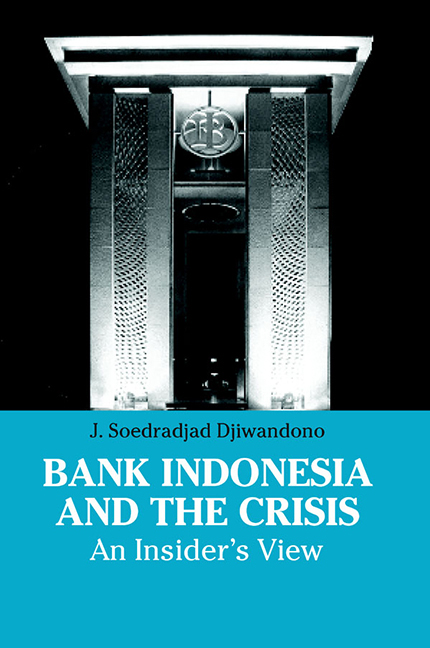Book contents
- Frontmatter
- Dedication
- Contents
- List of Tables
- Acknowledgements
- Glossary
- Prologue: The Crisis and Me
- 1 Introduction
- 2 Origin of the Crisis and Early Responses
- 3 Stabilization and Reform Programmes
- 4 Poor Programme Implementation
- 5 Stronger Programme with Weak Commitment
- 6 Bank Indonesia and the Crisis
- 7 Lessons from the Crisis
- 8 Epilogue
- Postscript
- Notes
- References
- Index
- About the Author
4 - Poor Programme Implementation
Published online by Cambridge University Press: 21 October 2015
- Frontmatter
- Dedication
- Contents
- List of Tables
- Acknowledgements
- Glossary
- Prologue: The Crisis and Me
- 1 Introduction
- 2 Origin of the Crisis and Early Responses
- 3 Stabilization and Reform Programmes
- 4 Poor Programme Implementation
- 5 Stronger Programme with Weak Commitment
- 6 Bank Indonesia and the Crisis
- 7 Lessons from the Crisis
- 8 Epilogue
- Postscript
- Notes
- References
- Index
- About the Author
Summary
Poor Implementation or Bad Programme?
The implementation of the IMF-supported programme started with the execution of the decision to close insolvent banks on 1 November 1997. In the jargon of IMF stand-by arrangements, this was a prior action, part of the conditionality. In fact it was a step that had to be taken by a recipient of a stand-by loan prior to the board deliberation to discuss the LOI sent by the member government to ask for a SBA.
The government announcement on the bank closures was made by The Minister of Finance, the Governor of Bank Indonesia and the Minister of Trade and Industry in the Ministry of State Secretariat, on 1 November 1997. Both the Minister of Finance and the Governor explained the background and the reasoning for the government's decision. Minister of Finance Mar'ie Muhammad explained in detail about the government policy of bank closures and the whole adjustment programme in the Parliament on 10 November 1997. In his explanation, he mentioned five criteria for a bank to be targeted for closure, which included: bank assets that could not cover liabilities; when a bank had insufficient income to meet its liabilities; caused by bad debts; a bank's inability to mobilize public funds, forcing it to rely on the inter-bank money market; negative net worth; and ignoring repeated warnings from the central bank.
The bank closures involved 16 banks with more than 400 offices all over Indonesia. A limited deposit guarantee was provided that was modelled on the liquidation of Bank Summa in 1992. At the liquidation of Bank Summa five years earlier, the government paid deposit owners a maximum of 10 million rupiah. This time, each deposit account was paid to the maximum of 20 million rupiah (approximately US$6,000). So, deposits equal to or less than 20 million rupiah would be paid the full amount, and those over it would be paid 20 million rupiah each. The number of deposit accounts equal to and less than 20 million rupiah of the closed banks numbered more than 660,000 accounts, which equalled to more than 94 per cent of the total number of deposit accounts of the closed banks.
- Type
- Chapter
- Information
- Bank Indonesia and the CrisisAn Insider's View, pp. 108 - 141Publisher: ISEAS–Yusof Ishak InstitutePrint publication year: 2005

